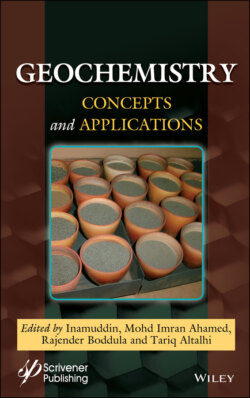Geochemistry

Реклама. ООО «ЛитРес», ИНН: 7719571260.
Оглавление
Группа авторов. Geochemistry
Table of Contents
List of Tables
List of Illustrations
Guide
Pages
Geochemistry. Concepts and Applications
Preface
1. Toxic Geogenic Contaminants in Serpentinitic Geological Systems: Occurrence, Behavior, Exposure Pathways, and Human Health Risks
1.1 Introduction
1.2 Serpentinitic Geological Systems. 1.2.1 Nature, Occurrence, and Geochemistry
1.2.2 Occurrence and Behavior of Toxic Contaminants. 1.2.2.1 Chrysotile Asbestos
1.2.2.2 Toxic Metals
1.2.2.3 Rare Earth Elements
1.3 Human Exposure Pathways. 1.3.1 Occupational Exposure
1.3.2 Non-Occupational Exposure Routes. 1.3.2.1 Inhalation of Contaminated Particulates
1.3.2.2 Ingestion of Contaminated Geophagic Earths
1.3.2.3 Ingestion of Contaminated Drinking Water
1.3.2.4 Ingestion of Contaminated Medicinal Plants
1.3.2.5 Ingestion of Contaminated Wild Foods
1.4 Human Health Risks and Their Mitigation. 1.4.1 Health Risks. 1.4.1.1 Chrysotile Asbestos
1.4.1.2 Toxic Metals
1.4.1.3 Rare Earth Elements
1.4.2 Mitigating Human Exposure and Health Risks
1.4.2.1 Risk Analysis
1.4.2.2 Risk Evaluation
1.4.2.3 Risk Mitigation
1.4.2.4 Overview of Mitigation Interventions
1.5 Future Perspectives
1.6 Conclusions
Acknowledgements
References
2. Benefits of Geochemistry and Its Impact on Human Health
2.1 Introduction
2.2 General Overview of Geochemistry and Human Health
2.2.1 Types of Geochemistry
2.2.2 Some Beneficial Effect of Some Mineral With Health Benefits
2.2.2.1 Magnesium
2.2.2.2 Manganese
2.2.2.3 Calcium
2.2.2.4 Cobalt
2.2.2.5 Copper
2.2.2.6 Zinc
2.2.2.7 Iron
2.2.2.8 Sodium
2.2.2.9 Arsenic
2.2.2.10 Chlorine
2.2.2.11 Iodine
2.2.2.12 Potassium
2.2.2.13 Fluoride
2.2.3 Application of Geochemistry on Human Health
2.3 Conclusion and Recommendations
References
3. Applications of Geochemistry in Livestock: Health and Nutritional Perspective
3.1 Introduction
3.2 General and Global Perspective About Geochemistry in Livestock
3.3 Types of Geochemistry and Their Numerous Benefits
3.3.1 Analytical Geochemistry
3.3.2 Isotope Geochemistry
3.3.3 Low Temperature Geochemistry
3.3.4 Organic and Petroleum Geochemistry
3.4 Application of Geochemistry in Livestock
3.5 Geochemistry and Animal Health
3.6 General Overview of Geochemistry in Livestock’s Merits of Geochemistry/Essential Minerals in Livestocks
3.6.1 Specific Examples of Authors That Have Used Essential Minerals in Livestock
3.6.2 Livestock in Relation to Geominerals
3.6.3 Trace Minerals Parallel Importance in Livestock
3.6.4 Heavy Metals Impact Livestock
3.7 Conclusion and Recommendations
References
4. Application in Geochemistry Toward the Achievement of a Sustainable Agricultural Science
4.1 Introduction
4.2 General Overview on the Utilization of Geochemistry and Their Wide Application on Agriculture
4.2.1 Classification
4.2.2 Chemical Composition of Rocks
4.2.3 Effect of Some Beneficial Minerals in Agriculture
4.2.4 Beneficial Mineral Nutrients That are Crucial to the Development of Plants
4.2.4.1 Micronutrients
4.3 Role of Geochemistry in Agriculture
4.4 Geochemical Effects of Heavy Metals on Crops Health
4.5 Conclusion and Recommendations
References
5. Geochemistry, Extent of Pollution, and Ecological Impact of Heavy Metal Pollutants in Soil
5.1 Introduction
5.2 Material and Methods. 5.2.1 Review Process
5.2.2 Ecological Risk Index
5.3 Toxic Heavy Metal and Their Impact to the Ecosystems. 5.3.1 Arsenic
5.3.2 Cadmium
5.3.3 Chromium
5.3.4 Copper
5.3.5 Lead
5.3.6 Nickel
5.3.7 Zinc
5.4 Metal Pollution in Soil Across the Globe
5.5 Ecological and Human Health Risk Impacts of Heavy Metals
5.6 Conclusion
References
6. Isotope Geochemistry
6.1 Introduction
6.2 Basic Definitions. 6.2.1 The Notation
6.2.2 The Fractionation Factor
6.2.3 Isotope Fractionation
6.2.3.1 Kinetic Isotope Fractionation
6.2.3.2 Equilibrium Isotope Fractionation
6.2.4 Mass Dependent and Independent Fractionations
6.3 Application of Traditional Isotopes in Geochemistry. 6.3.1 Geothermometer
6.3.2 Isotopes in Biological System
6.3.2.1 Carbon (C)
6.3.2.2 Nitrogen (N)
6.3.3 Isotopes in Archaeology
6.3.4 Isotopes in Fossils and the Earliest Life
6.3.5 Isotopes in Hydrothermal and Ore Deposits
6.4 Non-Traditional Isotopes in Geochemistry
6.4.1 Application in Tracing of Source
6.4.2 Application in Process Tracing
6.4.3 Biological Cycling
6.5 Conclusion
References
7. Environmental Geochemistry
7.1 Introduction
7.2 Overview of the Environmental Geochemistry
7.3 Conclusions
7.4 Abbreviations
Acknowledgment
References
8. Medical Geochemistry
8.1 Introduction
8.2 The Evolution of Geochemistry
8.3 This Science has Expanded Considerably to Become Distinct Branches
8.3.1 Cosmochemistry
8.3.2 The Economic Importance of Geochemistry
8.3.3 Analytical Geochemistry
8.3.4 Geochemistry of Radioisotopes
8.3.5 Medical Geochemistry and Human Health
8.3.6 Environmental Health and Safety
8.4 Conclusion
References
9. Inorganic Geochemistry
9.1 Introduction
9.2 Elements and the Earth
9.2.1 Iron
9.2.2 Oxygen
9.2.3 Silicon
9.2.4 Magnesium
9.3 Geological Minerals
9.3.1 Quartz
9.3.2 Feldspar
9.3.3 Amphibole
9.3.4 Pyroxene
9.3.5 Olivine
9.3.6 Clay Minerals
9.3.7 Kaolinite
9.3.8 Bentonite, Montmorillonite, Vermiculite, and Biotite
9.4 Characterization Techniques
9.4.1 Powder X-Ray Diffraction
9.4.2 X-Ray Fluorescence Spectra
9.4.3 X-Ray Photoelectron Spectra
9.4.4 Electron Probe Micro-Analysis
9.4.5 Inductively Coupled Plasma Spectrometry
9.4.6 Fourier Transform Infrared Spectroscopy
9.4.7 Scanning Electron Microscopy Analysis
9.4.8 Energy Dispersive X-Ray Analysis
9.5 Conclusion
References
10. Introduction and Scope of Geochemistry
10.1 Introduction
10.1.1 Periodic Table and Electronic Configuration. 10.1.1.1 Periodic Table
10.1.1.2Electronic Configuration
10.2 Periodic Properties. 10.2.1 Ionization Enthalpy
10.2.2 Electron Affinity
10.2.3 Electro-Negativity
10.3 Chemical Bonding
10.3.1 Ionic Bond
10.3.2 Covalent Bond
10.3.3 Metallic Bond
10.3.4 Hydrogen Bond
10.3.5 Van der Waals Forces
10.4 Geochemical Classification and Distribution of Elements
10.4.1 Lithophiles
10.4.2 Siderophiles
10.4.3 Chalcophiles
10.4.4 Atmophiles
10.4.5 Biophiles
10.5 Chemical Composition of the Earth
10.6 Classification of Earth’s Layers. 10.6.1 Based on Chemical Composition
10.6.2 Based on Physical Properties
10.7 Spheres of the Earth
10.7.1 Geosphere/Lithosphere
10.7.2 Hydrosphere
10.7.3 Biosphere
10.7.4 Atmosphere
10.7.5 Troposphere
10.7.6 Stratosphere
10.7.7 Mesosphere
10.7.8 Thermosphere and Ionosphere
10.7.9 Exosphere
10.8 Sub-Disciplines of Geochemistry
10.9 Scope of Geochemistry
10.10 Conclusion
References
Index
WILEY END USER LICENSE AGREEMENT
Отрывок из книги
Scrivener Publishing
.....
25. Holmes, E.P. and Lavkulich, L.M., The effects of naturally occurring acids on the surface properties of chrysotile asbestos. J. Environ. Sci. Health, Part A, 49, 12, 1445–1452, 2014.
26. Bales, R.C., Surface chemical and physical behavior of chrysotile asbestos in natural waters and water treatment, Keck Laboratories of Environmental Engineering Science, Division of Engineering and Applied Science, California Institute of Technology, Pasadena, CA. Report No. AC-8-84, 1984.
.....